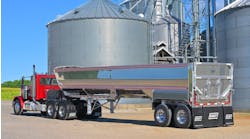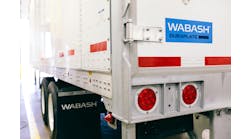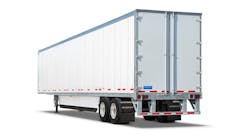With proposed fuel-efficiency standards hitting home, analysis shows that tractor-trailer with high aluminum content would save 5.7%
A tractor-trailer combination with “high aluminum content” would save 3300 pounds, resulting in 6.5% more payload or 6.5% fewer trips, along with a 5.7% fuel savings over the course of a year for the average fleet, according to a study commissioned by the Aluminum Association.
Doug Richman, vice-president of engineering for Kaiser Aluminum and a member of the technical and executive committees of the Aluminum Association's Aluminum Transportation Group (ATG), said the results are significant given rising energy costs, a growing concern over greenhouse gas emissions, Federal mandates that continue to add weight to heavy-duty vehicles, and first-ever fuel efficiency standards that have been proposed.
Mandates in 2002, 2007, and 2010 have added 850 pounds and reduced fuel economy by 8%. And with the fuel-efficiency standards for medium- and heavy-duty trucks proposed by the National Highway Traffic Safety Administration (NHTSA) and Environmental Protection Agency (EPA), emissions reductions between 10% and 20% are being sought by 2017.
“No single technology on the engineering horizon will achieve 20%,” Richman said. “This will require significant attention to vehicle design, improvements in powertrains and, in heavy trucks, a lot of work is being done on aerodynamics and tire rolling resistance. We've learned in the vehicle-design area that aluminum-based weight-reduction technologies can achieve a 3300-pound weight reduction in tractor-trailer combinations for Class 8 vehicles. And that 3300 pounds achieves a net 6% improvement in fuel economy for that class of vehicle. When working together to achieve a 20% reduction overall, 6% is a large contribution to the overall requirement.
“Aluminum componentry is all based on technology and parts that are currently available, fully developed, and, in many cases, have been in the marketplace for years. The issue is just deploying them in this market sector. We have learned from our studies that while we're going to do aggressive engineering improvements in all product areas, weight reduction is an additive to all other technologies.”
Todd Summe, division manager of product design & development for Alcoa and a member of the ATG's technical committee, said the purpose of the study — an analytical simulation performed by Ricardo Engineering — was to quantify the fuel-economy impact of weight reduction with aluminum specific to US drive cycles.
The cycles were: Highway Fuel Economy Test, one of the EPA's official highway cycles, designed for medium- to high-speed operation, with no mid-cycle stops; Heavy-Duty Urban Dynamometer Drive Schedule, one of the EPA's drive cycles for heavy-duty vehicles, with several idle and start-stop positions and many acceleration and deceleration events; and West Virginia University Interstate Drive Cycle, which simulates interstate operation, with speeds that vary from medium to high and many moderate acceleration events.
The vehicles were unloaded, one-half GVW load, and full GVW, with a 13-liter diesel engine and 10-speed automated manual transmission, and a coefficient of drag of .60 (baseline).
The conventional (baseline) vehicle configuration was 29,500 lbs (16,000-lb tractor, 13,500-lb trailer); “traditional lightweight” was 28,000 (15,500-lb tractor, 12,500-lb trailer) for a 5.1% savings of 1,500 pounds; and the “high aluminum content” was 26,200 (14,500-lb tractor, 11,700-lb trailer) for an 11.2% savings of 3,300 pounds.
The “high aluminum content” configuration had a payload of 53,800-lb payload for a 6.5% increased payload. Compared to the conventional configuration, it had its best fuel-economy savings in the HUDDS drive cycle (5.7% unloaded, 4% at half load).
“You can carry 3,300 lbs or 6.5% more cargo at GVW,” Summe said. “There is improved fuel efficiency, with as high as 1,612 gallons each year for a weight-constrained vehicle. That's nearly one billion gallons of diesel annually for the current US fleet. There's reduced CO2 emissions: up to 17.9 tons annually for a weight-constrained vehicle. That's approximately 10 million tons of CO2 per year for the current US fleet.”








